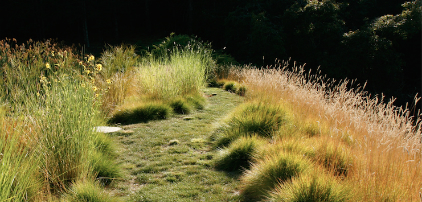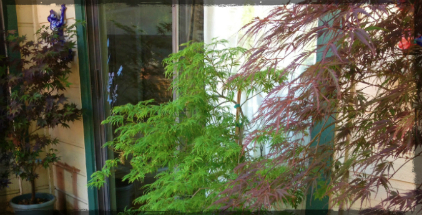For years Japanese maples were an elusive wonderment to me.
I would see beautiful photos of them in gardens from Oregon to
Washington D.C., but thought that it was way too hot and dry here
in central Texas to even try growing them, especially since the
costs can be scary.
Fast forward to the present and I must admit I’ve made a complete
about-face on the subject. My deck is now full of beautiful maples
and there are a number of fellow gardeners all over Austin who
are successfully growing them in the ground.
There are some simple tricks to make this beautiful tree grow here.
The biggest trick of all is shade. While in northern climates and on
the West Coast maples grow with abandon in full sun, they will
quickly scorch to a crisp in the 100 degree heat of our summers.
High shade to limited morning sun is the best location for these
trees.
Another trick is to work good compost into the soil. There are some
maples growing happily on Brodie Lane in south Austin in rocky
soil, but much of the rock has been removed so the roots don’t have
to work as hard to grow.
While acidic soil is not necessary, giving them a leg up with better
soil goes a long way in our temperamental growing environment.
In addition, providing these delicate trees with even moisture and
good drainage is critical. In the shade the even moisture part is not
too difficult. A deep watering twice a week on an established tree
is sufficient in all but the hottest summers.
Drainage is the one to watch out for. If your yard tends to hold on
to water, planting in a raised bed or working in some granite and
organic matter to loosen up the existing soil may be the answer.
When in doubt, or short of the right spot in a shady location, try
planting your maple in a container. I’ve done this at my house,
and have found that Japanese maples can live long lives and really
flourish on a north or east facing deck. I use Metro Mix for my
maples, and Hasta Grow or HollyTone (an Espoma product) as an
organic fertilizer.
DO NOT use chemical fertilizers on these trees as they are super-
sensitive to chemical burn and do not need heavy feed to thrive.
Japanese maple leaves can tip-burn even in the shade during the
hottest parts of the summer, but by that point we are just a few
short months away from incredible fall color and then dormancy,
so I think a little edge raggedness in late summer is not too big a
deal.
There are several wonderful, easy to find Japanese maples worth
trying out here in Texas that tend to be the most heat tolerant.
Bloodgood, the old standby, an upright, wine colored variety and
its predecessor Emperor 1, a maple that holds its color a little
better in the shade, are two great options to start out with. A fav-
orite of mine is Tamukeyama, a weeping form of Japanese maple
that also bears beautifully graceful purplish-red lacy leaves.
Happy gardening everyone! ❦
(Our stock of maples is low at the moment, but we are easily
able to special order some trees for customers. Please contact
Russ at the nursery: 512 280 1192)






